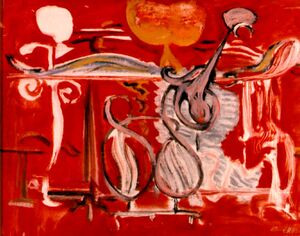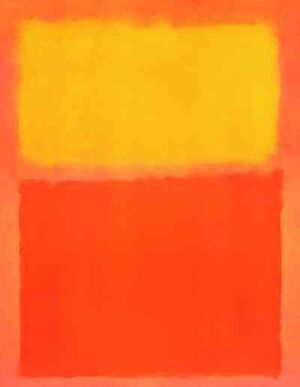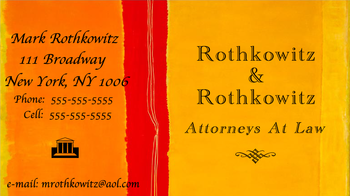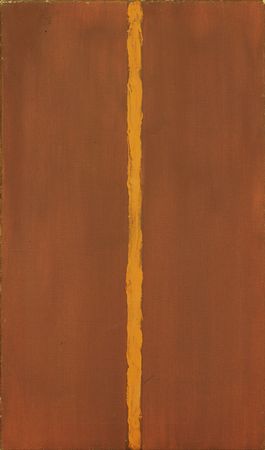Mark Rothko
Jump to navigation
Jump to search
| Mark Rothko (1903-1970) was a Latvian born, American artist who became famous for his color field, abstract expressionist paintings. Since he personally rejected those labels to describe his work and even bristled at the word “abstract”, it’s fair to throw in pretentious avante-garde nutjob as well. Early Career The first achievement of anyone who wishes to become an artist is to break your parent’s hearts by becoming “the special child” who ignores the economic realities of life and forgoes a lucrative or realistic career for the sake of hanging out with other people just like him or herself. Rothko accomplished this pre-requisite during the American Great Depression of the 1930’s and left his mother crying “why why why” many years before the phrase would be popularized by Nancy Kerrigan. Now that he had established himself as an artist, he needed to figure out which medium to use as a vehicle for his expression. Using his New York Jew connections he took some classes with Arshile Gorky and then Max Weber, both avante-garde painters, and was so inspired by the experience that he began writing a book about the inherent similarities between the art of children and the work of modern painters. This project would go unfinished since he really had no writing skills but the experience would be instrumental in Rothko’s next career move, to become an avante-garde painter. Finding His Niche Rothko was one of several young artists who became fawning lackeys of the older and established modern American painter Milton Avery, whose unique style is instantly recognizable to anyone with small children and gallery space on the refrigerator door. The Avery worshipers would eventually branch out into their own unique denominations but the binding idiom of the movement was the rejection of boundaries like meaning and representation for a more primitive and non-intellectual form of expression. Finding His Nietzsche The most important aspect of being an avante-garde artist is the ability to promote these blurry, abstract "expressions" as being something more than pretentious crap which can be easily reproduced by anyone with a pulse and a paint brush. Rothko needed to be fluent in rationalizing his existence and validating himself as a relevant artist to the average idiot who spends tens of thousands of dollars on watercolor paintings done by apes or LeRoy Neiman. Rothko found this existential inspiration in the self-aggrandizing mumbo jumbo of Friedrich Nietzsche and learned to garner attention to his paintings by getting into a frenzied drama queen state and hysterically claiming that his works were deep, profound statements and not just indiscriminate blobs of color. They were expressions that rejected societies expectation of technical expertise, actual talent and an artist's evolution over time. Eventually, this intentional devolution would lead to him hiring Mexican house painters to produce his later works. The genius of it all may be difficult to perceive if you're not an art expert but the fact that it's been recognized here on this webpage as genius should be good enough for a layperson like yourself to accept Rothko's work as the new status quo - which will destroy your barriers and force you to rethink your values and the meaning of truth. |
 An early Rothko that featured semi-recognizable shapes and blobs  A latter Rothko, probably done under the direction of the artist by a sub-contracted Mexican house painter |
Rothko was perpetually battling with a fellow Milton Avery disciple named Barnett Newman who made a niche for himself as the outspoken polar opposite of Rothko. Utilizing his writing skills, Newman whined excessively in order reinforce his self-established image as an artist and to whore his work - despite it looking exactly like Mark Rothko's with the exception of it being vertically oriented. Newman claimed that the horizontal orientation of Rothko's paintings was synonymous with catering to the philistine world. "My struggle against bourgeois society has involved the total rejection of it." exclaimed Newman in reference to Rothko's work. Newman essentially accused Rothko of "talking the talk while not walking the walk" in the beginning but the sassy bitching devolved into drunken boasts of his capacity to kick the diametrically opposed artist's ass sideways. |
Opinions vary widely about Rothko's work and subsequent legacy after his death. Some people hail him as a genius and other people simply can't believe that anyone in their right mind would pay large sums of money for what amounts to nothing more than a large, empty field inhabited by two colors and divided into individual boxes by a third color. Often times reproductions of Rothko's latter works get confused with samples of fancy stationery one might use to make snazzy newsletters, flyers or party invitations with - perhaps even a business card design.  Rothko took the spectacle of human tragedy to heart and lived an atrociously poor lifestyle of unhealthy food and excessive alcohol and tobacco smoking. Becoming bored with the slow progress of his own demise, he separated from his 2nd wife and eventually slashed his wrists in 1970 at the age of 66. His final works had become so minimalistic and void of tangible substance that the only expression left for Rothko was to completely disappear. |
| Featured version: 6 March 2010 | |
| This article has been featured on the main page. — You can vote for or nominate your favourite articles at Uncyclopedia:VFH. | |

